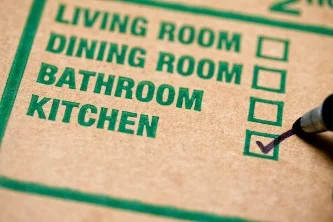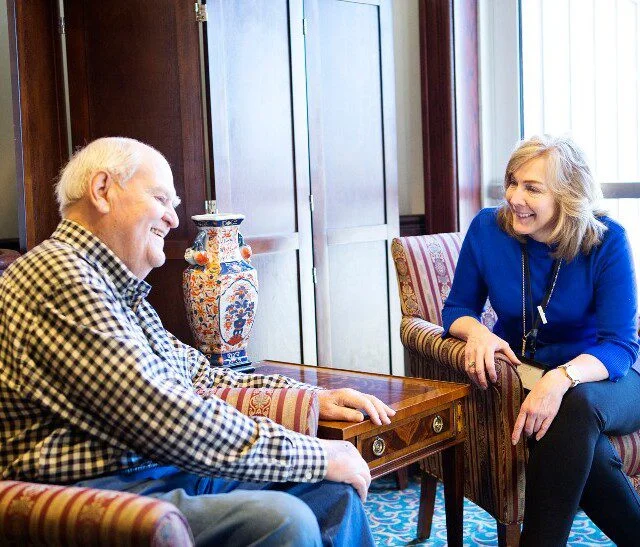Moving from your house to a senior living community is a big decision. Most of us have filled our homes with our favorite furniture, belongings, keepsakes and mementos. Just the thought of going through and boxing up the sheer volume of our possessions can be enough to keep us from starting. Plus, it’s likely that our new residence will be smaller – requiring us to let go of a good amount of our belongings. But it doesn’t have to be as daunting as it seems. That’s why we put together this ultimate checklist for downsizing to a senior living community.
But before we talk about how to go about paring down your possessions, let’s take a look at three advantages to downsizing you may have never considered.
You’ll be more organized
Simply put, moving to a smaller home forces you to eliminate clutter and get organized. It also helps you realize which things are truly important and which things you’ve kept around only because you had space for them. In fact, seniors who remain in a large home often use only a few rooms in their house … often just the bedroom, kitchen and living room, leaving the rest to gather clutter.
You’ll reduce your stress
Paring possessions like unneeded furniture, unused exercise machines and outdated electronics means fewer things to worry about. Clutter makes comfortable living difficult because things are always in the way, making it hard to walk around and find what you’re looking for. Simplifying your life through downsizing and organization frees you from worry and makes your life more manageable.
Your children will thank you
When you downsize your possessions, you relieve your children of the difficult burden of sorting through belongings later on. Plus, it can be quite enjoyable to give cherished items to your family and friends, knowing they’ll be appreciated for years to come.

Our checklist for downsizing
We know there are many advantages to downsizing, but it can be a daunting task. So, here are a few tips to get you started.
1. Have a plan
The first step in our checklist for downsizing is to develop a plan. Doing so will help reduce your emotional attachment to your possessions, get them organized and focus your thinking on the future.
But take your time. Going through a lifetime of memories can’t be done in a weekend – or even a week. Spend time reliving important memories and the good times each item brings to mind. You’ll enjoy remembering a significant event or person in your life, and doing so will bring a sense of satisfaction and closure as you realize it’s the memory, not the item, that is valuable.
Here are some ideas to consider when deciding what to let go of and what to keep:
Get rid of clutter
Go through your house one room at a time and pick out things you’re not using or aren’t emotionally attached to. This will get you in the proper mindset to let things go and set you up for success when you start going through more sentimental items.
Give it away
Donating items to family members or a nonprofit organization is a great alternative to throwing them away. Most of us have things we don’t use or need anymore, but those things still have value and may prove useful to someone else. Plus, giving important keepsakes and furniture to close friends and family allows you to see how happy those mementos make them. For a less special item, consider taking a picture of it, writing a brief history of the item and sharing it with family members. Then donate it to charity or sell it at a consignment shop or garage sale, knowing you’ve preserved the memory.
Take pictures
Take pictures of things in various rooms of your home so you can recreate your surroundings in your new space. Plus, it’ll help you keep track of important documents and treasured items. Be sure to include details such as furniture arrangements and where family photos were hung on your walls.
2. Consider your new space
If possible, print out a floor plan of your new living arrangements and start planning where your items will go in your new home. Be sure to think about:
The size of your new space
Moving from a four-bedroom home to a two-bedroom home will require a good amount of downsizing. Try to focus on the most important parts of how you live. Do you need a desk for writing or computer work? Will you really need a sleeper sofa in this next chapter of your life? The reality is, as you lived in your house, you developed a lifestyle and habits that you enjoy and work for you. So make room for those things and leave the rest behind. When you’re finally settled in your new digs, you’ll appreciate the familiarity of having things arranged in a similar fashion to your previous home.
Make an inventory
Now it’s time to be honest with yourself – is there realistically enough space for everything you’d like to keep? If not, consider a storage unit for oversized items or other possessions that won’t fit in your new residence. Many senior living communities offer storage units on-site for a nominal fee. More on this below.
Don’t forget about amenities
Think about what your new community offers in terms of amenities. Is there a workout facility? Are there restaurant-style dining options? If so, let someone else get some use out of your exercise bike and give some of your cookware to family members.
3. Contact a storage facility
After you’ve gone through your belongings and donated, sold or given away everything you can part with, you may still be left with more than your new residence can fit. That’s where a storage facility, as mentioned above, may be just what you’re looking for. But how do you decide what stays with you and what goes to storage? Here are two categories to consider:
Mementos
As we age, our memories become more and more important. A small storage unit provides a safe place to store sentimental items that won’t fit in your new living space.
Larger Items
Large electronics, valuable furniture and outdoor equipment are logical items to keep in a storage facility. Most units can be rented on a monthly basis, making temporary storage an option. Many also offer discounted prices for senior citizens.

Downsizing can be intimidating, but it doesn’t have to be. With appropriate planning, organization, and help from friends and family, you can navigate a hassle-free transition with ease. We hope this checklist for downsizing to a senior living community has been a helpful tool as you think about your future.
If you’re considering a senior living community, see everything Claridge Court has to offer by filling out the brief contact form below. A representative will be in touch soon to discuss your plans and help you navigate this important decision.


